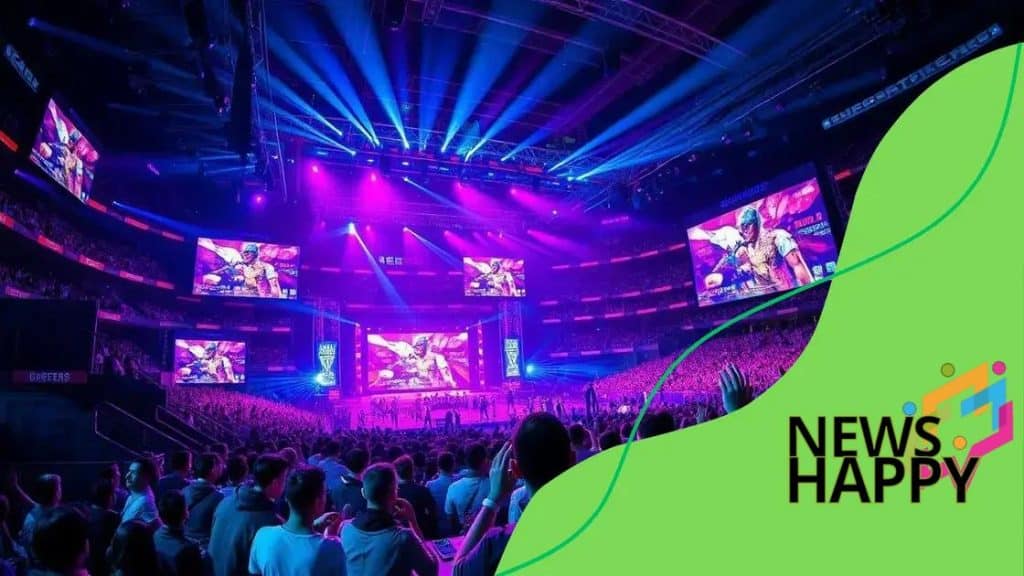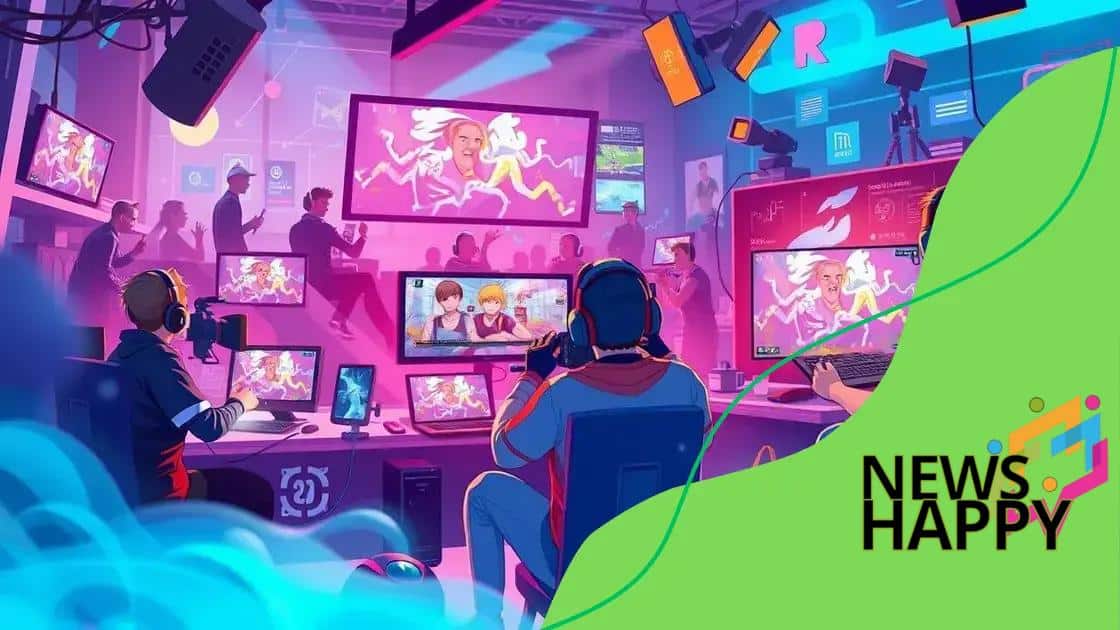How e-sports are influencing mainstream media content

Anúncios
How e-sports are influencing mainstream media content includes significant partnerships, emerging technologies like AI and VR, and a shift in audience engagement, redefining entertainment across platforms.
In recent years, how e-sports are influencing mainstream media content has become undeniable. This phenomenon is changing the way media platforms engage with audiences, blurring the lines between gaming and traditional entertainment. Have you noticed how e-sports events are now a staple in mainstream broadcasts?
Anúncios
The rise of e-sports and its cultural significance
The rise of e-sports has reshaped entertainment and culture around the world. As gaming becomes a prominent form of entertainment, its impact on popular culture is immense. More than just a game, e-sports now attracts millions of viewers and players alike.
Many factors contribute to the cultural significance of e-sports. For instance, e-sports fosters community and camaraderie among fans and players. As people gather in arenas or online to watch their favorite teams compete, they form connections and celebrate shared interests.
Key Elements of E-sports Culture
The culture of e-sports is built on several core elements:
Anúncios
- Competition: Skill-based contests that showcase player talent.
- Community: Supportive networks of fans and gamers actively engage with one another.
- Streaming: Platforms like Twitch allow players to broadcast their gameplay and connect with audiences.
- Recognition: Professional leagues and tournaments provide players with substantial fame and financial rewards.
This competitive atmosphere has made e-sports especially attractive to younger audiences. Players can idolize their favorite teams and players, mirroring the relationships found in traditional sports. E-sports events, with their high-energy environments, draw in massive crowds both in-person and online.
As corporations recognize this growth, sponsorship and branding opportunities have surged. Major brands now invest in e-sports, further integrating these events into mainstream culture. The blending of gaming and media has led to significant collaborations, including films, merchandise, and even documentaries focusing on this phenomenon.
Given its rapid evolution, the future of e-sports looks promising. With potential advancements in technology, we’re likely to see even more immersive experiences that enhance viewer engagement and interactive gaming.
How e-sports events are broadcasted
Broadcasting e-sports events has become a vital part of the gaming industry. With millions of fans tuning in to watch live competitions, the way these events are presented significantly affects viewer engagement and interest.
Using advanced technology, e-sports organizers create immersive experiences for viewers. Multi-camera setups and dynamic angles help showcase the intense action of games. Additionally, commentators provide real-time analysis, enhancing the excitement as well.
Platforms for Broadcasting
Several platforms are key in streaming e-sports events. Each offers unique features that cater to different audiences:
- Twitch: The most popular platform for live gaming, allowing viewers to interact with streamers.
- YouTube Gaming: A massive platform providing recorded matches and live streams with vast reach.
- Facebook Gaming: Engages users with a strong community aspect through shared interests.
- Dedicated e-sports networks: Channels specifically for e-sports content, often available on cable and online.
Aside from these platforms, social media plays a crucial role in promoting e-sports events. Fans share highlights and updates, expanding the reach and excitement of competitions. The presence of popular influencers also draws more viewers, as they often host streaming events or provide commentary.
Moreover, pre- and post-game shows have become common, adding extra layers of entertainment. These segments often include analysis of game strategies and player performances, enhancing the viewing experience. As a result, audiences feel more connected to the events, fostering a sense of community.
As technology advances, we can expect even more engaging broadcast options in the future. Innovations like augmented reality and virtual reality are poised to change how we experience e-sports events. This evolution will likely attract new audiences and enhance the overall viewing experience.
The impact of e-sports on content creation

The impact of e-sports on content creation has become significant as gaming reaches mainstream audiences. With the rise of popular titles, content creators have found new opportunities to connect with fans and develop unique materials that are both engaging and informative.
E-sports not only influences how content is created but also the types of content being produced. Streamers and gamers share their gameplay experiences, offering live commentary and reactions that resonate with viewers. This real-time interaction creates a vibrant community that is deeply engaged with the content.
Types of Content Influenced by E-sports
There are various forms of content that have evolved due to e-sports:
- Tutorials: Content creators share guides on gameplay strategies, helping others improve their skills.
- Highlights: Short clips showcasing amazing plays or funny moments attract viewers and keep engagement strong.
- Vlogs: Many gamers document their experiences attending events, offering fans a behind-the-scenes look.
- Collaborations: Partnerships between content creators and e-sports teams lead to unique series and promotional material.
As a result, the relationship between e-sports and content creation is mutually beneficial. E-sports events provide creators with valuable material to share, while content creators help promote the events and the games themselves. The cycle continues as both the gaming industry and content creation communities evolve together.
Additionally, brands are increasingly recognizing the power of e-sports in content marketing. Many companies partner with gamers or streamers to reach new audiences. This trend creates innovative advertising strategies that blend seamlessly with the content itself, making it more relatable to viewers.
Furthermore, platforms like Twitch and YouTube have become essential for distributing this content. These platforms provide a space for gamers to showcase their skills and connect with their audience in real-time. The ability for viewers to interact directly with content creators fosters a more personal relationship, leading to higher loyalty and engagement.
E-sports collaborations with traditional media
E-sports collaborations with traditional media have become increasingly common as the popularity of gaming continues to rise. These partnerships offer a unique blend of entertainment that captures audiences from both the gaming and traditional sports worlds.
Media outlets recognize the potential of e-sports to engage younger demographics. Notable collaborations include networks broadcasting tournaments, creating documentary series, or even covering leagues like League of Legends and Overwatch. Through these broadcasts, traditional media enhances its offerings with fresh, dynamic content.
Types of Collaborations
There are several forms of collaborations between e-sports and traditional media:
- Event Broadcasting: Major tournaments are broadcast on television and streaming platforms, allowing fans to watch live.
- Documentaries: These tell the stories of players and teams, providing behind-the-scenes insights into the e-sports world.
- Sponsored Content: Brands create content featuring popular gamers, integrating it into traditional media channels.
- Mixed Events: Traditional sports organizations host e-sports tournaments, blending audiences and expanding reach.
This integration benefits both sides. E-sports gains exposure and credibility, while traditional media attracts new viewers eager for innovative content. The merging of these worlds not only expands the audience but also boosts engagement, as fans are more inclined to participate in both mediums.
As technology evolves, collaborations become more advanced. Innovations like augmented reality are being tested during broadcasts, creating an even more engaging viewer experience. These technologies can enhance storytelling, making the content more immersive.
Moreover, notable figures from traditional sports increasingly get involved in e-sports. Athletes from various sports have started investing in e-sports teams, further bridging the gap between the two industries. As a result, fans find new ways to connect with their favorite players, whether in a traditional match or an e-sports event.
Future trends in e-sports and media relations
Future trends in e-sports and media relations are an exciting topic as the industry continues to evolve. With rapid advancements in technology, the way audiences consume content is changing dramatically. This shift is shaping new opportunities for both e-sports and traditional media.
One major trend is the increasing use of artificial intelligence and analytics. These technologies help content creators understand viewer preferences and improve engagement. By tailoring content to specific audiences, e-sports broadcasters can enhance the viewer experience significantly.
Emerging Technologies
Innovative technologies will continue to transform how e-sports and media interact:
- Virtual Reality (VR): VR technology allows fans to immerse themselves in e-sports events as if they were physically present. This offers a unique viewing experience unlike any other.
- Augmented Reality (AR): AR can add layers of information to broadcasts, providing real-time stats and player insights during competitions.
- Interactive Content: Viewers will increasingly participate in events through polls, live chats, and even in-game decisions that affect the outcome of matches.
Furthermore, social media platforms are becoming essential tools for e-sports marketing and promotion. They allow players and teams to build personal brands and communities around their content. Success on platforms like Twitter, TikTok, and Instagram can significantly boost visibility and engagement.
As traditional media outlets adapt to these trends, collaborations with e-sports entities will likely grow. Partnerships can lead to unique programming that highlights not just the events, but also the culture and lifestyle surrounding e-sports. This could include reality shows featuring gamers or interview segments with industry leaders.
The global nature of e-sports also means that media relations strategies will need to consider various cultural contexts. Content that resonates in one region may not have the same impact elsewhere. This creates an exciting challenge for creators, as they develop content that appeals to diverse audiences.
FAQ – Frequently Asked Questions about E-sports and Media Relations
How are e-sports changing traditional media?
E-sports are attracting younger audiences, prompting traditional media to broadcast events and create engaging content.
What technologies are shaping the future of e-sports?
Innovations like artificial intelligence, virtual reality, and augmented reality are enhancing viewer experiences in e-sports.
Why are partnerships between e-sports and media important?
These collaborations create unique content and reach diverse audiences, increasing engagement and promoting events effectively.
What role does social media play in e-sports?
Social media helps gamers build personal brands and connect with fans, boosting visibility and interaction with their content.





